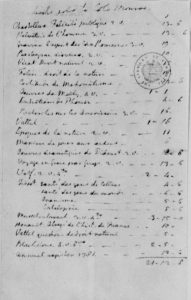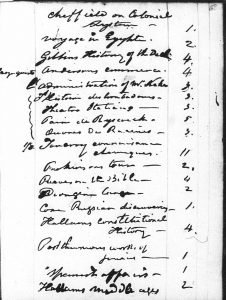Assembling the contents of Monroe’s library required the use of a variety of sources. The most comprehensive were from a series of catalogues that he created throughout his lifetime, originals of which are held by the Library of Congress, the James Monroe Museum, and the New York Public Library. These catalogues were made during distinct periods of his political career and reflect his personal and professional interests.
Early Political Career

Jefferson’s list of books sold to Monroe in 1784 (Library of Congress)
Monroe’s earliest recorded purchase is a collection of books acquired from Thomas Jefferson in 1784. Monroe had previously read law under Jefferson in 1778, and the two men were serving as delegates to the 1783 session of the Continental Congress in Annapolis. They had also been rooming together at a nearby lodging house. At the end of the session, Monroe purchased a collection of 24 disparate titles, with topics ranging from history to medicine, legal philosophy to dramatic literature, religion to chess. Notable within this grouping were two particular works that stayed with him for the remainder of his life: Emmerich Vattel’s Law of Nations, a cornerstone of American foreign policy from the country’s earliest days, and William Blackstone’s Commentaries on the English Law, which is also listed in the 1849 auction of the remainder of Monroe’s library.
Diplomatic Years

Excerpt from Monroe’s travel journal, listing books purchased in Europe and America (image courtesy of the New York Public Library)
Excerpt of Monroe’s record of books purchased while in Paris, Madrid, London, and New York from 1803 – 1807Monroe’s next documented acquisitions came during his years as a diplomat to France, Spain, and England, from 1803 – 1807. In a list recorded in his travel journal, Monroe noted 90 titles that he added to his library from cities such as Paris and London, and from New York upon his return to the United States. He acquired books from all categories – science, religion, history, literature, the arts – and in several languages. He sought out numerous texts on science, including an 11-volume set of Fourcroy’s notable work on chemistry, and many others. Several of his purchases were made with his daughters in mind, such as a trigesimo-secundo (3.5 x 5.5 inches) copy of Homer’s Illiad and a side by side French/English translation of The Adventures of Telemachus for his daughter Maria.
The Presidency

Monroe’s handwritten catalogue of books, begun in 1810 (image courtesy of the James Monroe Museum)
Monroe’s most active period of acquisition came during his terms as secretary of state and president. He purchased many books that would have served as resources for both foreign and domestic concerns, as well as to the ongoing development of policy decisions. It is also during this period that he completed the acquisition of several extensive multi-volume sets, to include 46 volumes of the British Statutes at Large, 30 volumes of Buffon’s Histoire Naturelle, and 30 volumes of the “highly illustrated” complete collection of the works of Voltaire.
Retirement Library

1849 auction catalogue of the “Remainder” of Monroe’s library (Library of Congress)
Monroe fully expected to retire from public service following his return from his second diplomatic posting in 1807. Nearly two decades later, having held more public offices than any other president, he settled into retirement on his farm in Virginia. He noted in 1827 that “The arrangment of my papers, relating to such occurrences, from very early life, occupies a portion of my time. My books, another portion, my farm the residue…” (James Monroe to Charles Ingersoll, 25 April 1827). The titles that occupied his time are in keeping with his previous interests of classical and modern history, political philosophy, and the sciences. His involvement in the early efforts of the founding of the country over which he had presided as a two term president is seen not only in the acquisition of such titles as “The Biography of the Signers of the Declaration of Independence,” but in his choice to display a framed copy of the Declaration of Independence in his library at Oak Hill, along with a sword and a brace of pistols.

Description of Monroe’s library, from 1836 property inventory of Oak Hill (image courtesy of the James Monroe Museum)
